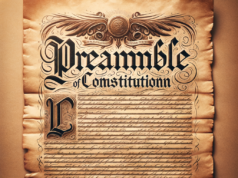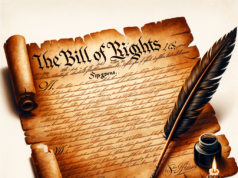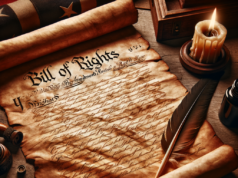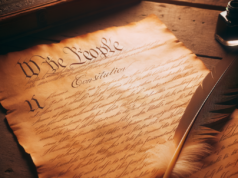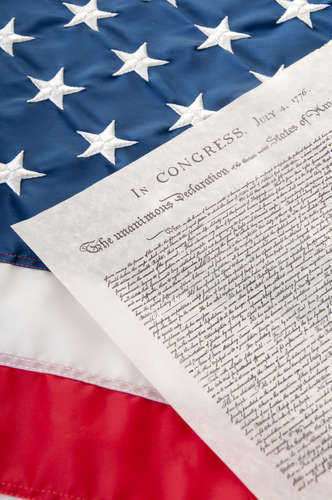
The Tenth Amendment to the United States Constitution states, “The powers not delegated to the United States by the Constitution, nor prohibited by it to the states, are reserved to the states respectively, or to the people.” This amendment is part of the Bill of Rights and is one of the most crucial amendments to the Constitution as it defines the relationship between the federal government and the individual states.
The Tenth Amendment was introduced on December 15, 1791, along with the rest of the Bill of Rights. It was proposed to limit the power of the federal government and prevent it from infringing on the rights of individual states. The amendment’s primary purpose was to ensure that the federal government would not become too powerful and instead allow the states to govern themselves on issues that were not explicitly granted to the federal government.
The Tenth Amendment gives state governments the power to create their laws to govern their people. It grants the states the authority to regulate or ban activities that the federal government lacks the power to regulate or prohibit. For example, the federal government cannot interfere in issues such as the use of motor vehicles on state highways or the sale of alcohol within individual states.
The amendment does not explicitly define the limits of the powers reserved for the states, but it lays the groundwork for the idea that the federal government should have limited power in comparison to the individual states. It creates a balance of power between the federal government and states, known as federalism, which is unique to the United States and its political system.
The Tenth Amendment’s significance lies in the fact that it creates dual sovereigns within the country. It gives states the power to govern themselves without the interference of the federal government unless the Constitution explicitly grants the authority to the federal government.
The Tenth Amendment has been a crucial part of many legal cases throughout American history, and it remains an essential reference point in legal arguments made today. One of the most notable cases is the landmark Supreme Court decision in New York v. United States in 1992, in which the court held that the Tenth Amendment forbids Congress from compelling states to implement federal regulations.
Additionally, the Tenth Amendment has also influenced the future laws of the individual states. It has allowed states to create their laws to govern their people as they see fit. For example, many states have legalized marijuana for medical and recreational use, and others have banned the practice altogether. The Tenth Amendment has given states the right and authority to regulate such instances independently.
The Tenth Amendment has also played a significant role in resolving disputes between the state and federal governments. It has been used in arguments for and against various federal laws and regulations, including the Affordable Care Act, gun control regulations, and same-sex marriage laws. For instance, some states have argued that the federal government oversteps its bounds under the Tenth Amendment with the Affordable Care Act, known as Obamacare.
It is significant to note that the Tenth Amendment was formed after the American Revolution, where the thirteen colonies won their independence from British rule. The idea of federalism emerged from this period, which emphasized the importance of states’ rights and placed higher powers in the hands of the people. This amendment was a way to ensure that the distaste for a ruling power did not occur again.
Compared to many countries globally, the concept of federalism with the focus on states’ rights is unique to the United States. Many other countries have more centralized forms of government, where powers are concentrated in a national government, with very little sovereignty given to subnational entities. In contrast, in the United States, the emphasis on states’ rights is evident at various levels of government, from the legislative branch to the executive branch and the judicial system.
The history of the United States offers significant examples of the tensions that arise between the federal government and individual states, eventually leading to the basis of the Tenth Amendment. During the American Civil War, when the southern states seceded from the Union, the issue of states’ rights played a significant role. The southern states claimed that they had the right to govern themselves and that the federal government had overstepped its bounds by attempting to abolish slavery. In contrast, the federal government argued that it had the authority to put an end to slavery under the Constitution. The Civil War precisely demonstrates the importance of balance between federalism, or national authority, and states’ rights in the United States.
Finally, the Tenth Amendment has also played an influential role in shaping the country’s political landscape. It has been used to support arguments for many ideological stances, including conservative constitutionalism and liberal federalism. Conservatives have argued that the Tenth Amendment limits the power of the federal government and must be strictly adhered to. On the other hand, liberals have used the Tenth Amendment to support states’ rights in issues such as environmental regulations and immigrant rights.
In conclusion, the Tenth Amendment to the United States Constitution has played an essential role in the country’s political and legal system since its introduction as part of the Bill of Rights. Its primary purpose was to limit the power of the federal government and prevent it from infringing on the rights of individual states. It has granted the states the authority to regulate or ban activities that the federal government lacks the power to regulate or prohibit. Its influence on the United States is still evident; it has played a significant role in shaping the country’s political landscape, the judicial system, the creation of state laws, and resolving disputes between states and the federal government. Compared to many countries globally, the emphasis on states’ rights is unique to the United States, and the Tenth Amendment remains a crucial precedent for the division of power between the federal government and states.
The Tenth Amendment bears a certain resemblance to the ninth Amendment that it grants authority or powers to a certain faction that are not explicitly included or enumerated under the United States Constitution. However, in the case of the Tenth Amendment, the powers granted are to the State, rather than certain natural rights to individuals.
The text of the 10th Amendment reads, “The powers not delegated to the United States by the Constitution, nor prohibited by it to the States, are reserved to the States, respectively, or to the people.”
Under the United States Constitution, there are certain provisions that place responsibility or authoritative powers to the Federal government. However, other powers not strictly assigned to the central Government, and not explicitly restricted to the State, are to be granted to the States themselves.
The most important concept behind the Tenth Amendment is that it provides for the general principles of Federalism as the form of the United States Government. Federalism is the system of government in which the power to govern is shared between a national or central government and the state governments, which is divided under Constitutional provisions. This concept had already been addressed under certain provisions of the Articles of Confederation and was, once again, reflected in the drafting of the Constitution.
Under the Constitution, the branches of government–the executive, legislative, and judicial–are granted powers as the central or Federal Government. The Tenth Amendment serves as a system of checks and balances by providing certain authority to the States, which would prevent the central Federal Government from garnering too much power and creating the potential of what the United States already had experienced with England.
The Tenth Amendment is evident in today’s world and has modern applications. States will employ the Tenth Amendment in certain situations when they seek exemption from regulations created by the Federal Government. Federalism allows for states to impose certain laws that are to be governed by each individual state.
States will often have their own labor and environment controls that are free from Federal statutes. Such was the case inNew York v. the United States, where certain Federal laws imposed certain regulations regarding the Low-Level Radioactive Waste Policy Amendments Act. A particular provision was questioned and brought before the Supreme Court, with the State of New York claiming that the Federal Government did not have the authority to hold states liable for damages regarding waste. Under Federal provisions, States were responsible for all waste within their borders and would be liable for any damages incurred by such waste. The Tenth Amendment was upheld and the Supreme Court ruled that such an imposition violated the provisions under the Amendment.
Another example would be the Brady Handgun Violence Prevention Act, which required all states to conduct background checks on those seeking to purchase handguns. The Tenth Amendment would also render this Federal legislation as unconstitutional.
One of the current topics of controversy under the Obama Administration is in regard to an application of the Tenth Amendment to State medical marijuana laws. Currently, there are fourteen states that have implemented marijuana laws that permit its use for medical purposes. The passing of such state laws is legal under the Tenth Amendment, but the dispute arises out of the authority the Federal Government has over laws regarding illicit or controlled substances.




